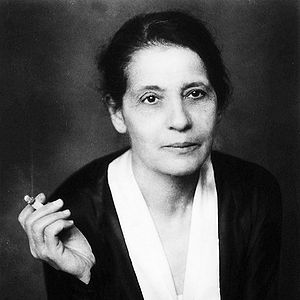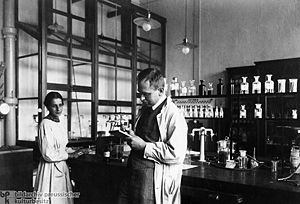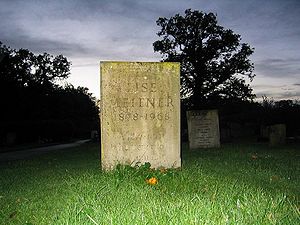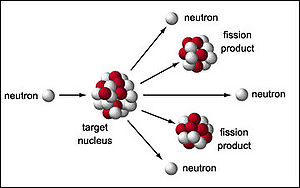Lise Meitner: Difference between revisions
No edit summary |
No edit summary |
||
| (34 intermediate revisions by the same user not shown) | |||
| Line 1: | Line 1: | ||
Created | Created by Olivia Pool, PHYS 2211, Section N06 | ||
[[File:LMpic.jpg|300px|thumb|Lise Meitner in her later years.]] | [[File:LMpic.jpg|300px|thumb|Lise Meitner in her later years.]] | ||
| Line 6: | Line 6: | ||
==Personal Life== | ==Personal Life== | ||
===Early Life=== | ===Early Life=== | ||
Lise Meitner was born in Vienna, Austria, on November 7, 1878, as the third of eight children. Her father was a lawyer from Moravia and strongly supported equal education for his sons and | Lise Meitner was born in Vienna, Austria, on November 7, 1878, as the third of eight children. After showing early excellence in mathematics, she received private tutoring, and her passion for learning continued to grow. Her father was a lawyer from Moravia and strongly supported equal education for his sons and daughters. Her mother's family had emigrated from Russia to Slovakia. Although they were Jews, the Meitners did not practice their religion, and most of the Meitner children converted to Catholicism. | ||
===Life in Academia=== | ===Life in Academia=== | ||
Even though she became a Protestant in 1908, Meitner forced to leave Germany in 1938 | [[File:MeitnerHahn.jpg|300px|thumb|Meitner and Hahn hard at work.]] | ||
In 1901, Meitner entered the University of Vienna, studying physics under Ludwig Boltzmann. After becoming the second woman to receive a PhD in Physics from the University of Vienna in 1906, she moved to Berlin to study with Max Planck, a physicist. For nearly seven years, Meitner worked as Planck's unpaid Physics Department assistant and published work on radioactive properties. It was very uncommon for women to be working in the lab at this time, however Meitner's program allowed her to interact with chemists in addition to other physicists. At this time, she met Otto Hahn, a chemist she would collaborate with for over 30 years. In 1922, Meitner became a university lecturer while also continuing her research on radioactive properties. | |||
Even though she became a Protestant in 1908, Meitner was forced to leave Germany in 1938 after the rise of Adolf Hilter due to her Jewish heritage. She moved to Sweden where she worked at Manne Siegbahn's institute in Stockholm, but due to Siegbahn's prejudice again women in science, she received very little support. Hahn and Meitner were able to meet secretly in Sweden to continue their experiments. Their research was published in 1939 and provided evidence for nuclear fission, a discovery that ultimately aided the Manhattan Project and the creation of the atomic bomb. | |||
In 1944, Hahn was awarded the Nobel Peace Prize for Chemistry because of the research, but Meitner was overlooked. Meitner was awarded the Enrico Fermi Award along with Hahn in 1966. However, the Nobel mistake was never acknowledged. | In 1944, Hahn was awarded the Nobel Peace Prize for Chemistry because of the research, but Meitner was overlooked. Meitner was awarded the Enrico Fermi Award along with Hahn in 1966. However, the Nobel mistake was never acknowledged. | ||
In 1960, Meitner retired to Cambridge, England, before passing away on October 27, 1968. | In 1960, Meitner retired to Cambridge, England, before passing away on October 27, 1968. | ||
[[File:MeitnerGrave.jpg|300px|thumb|Lise Meitner's grave in Bramley,England.]] | |||
==Scientific Contributions== | ==Scientific Contributions== | ||
| Line 21: | Line 26: | ||
Meitner's experiments with Hahn provided evidence for nuclear fission and led to the creation of the atomic bomb. | Meitner's experiments with Hahn provided evidence for nuclear fission and led to the creation of the atomic bomb. | ||
In 1934, a scientist by the name of Enrico Fermi discovered that he could produce radioactive isotopes by neutron bombardment | [[File:NuclearFission.jpg|300px|thumb|left|A representation of nuclear fission]] | ||
In 1934, a scientist by the name of Enrico Fermi discovered that he could produce radioactive isotopes by neutron bombardment. This inspired Meitner and Hahn to complete experiments with uranium alongside their assistant, Fritz Strassman. After bombarding uranium with neutrons, they expected to find radium, but discovered that their product was actually barium. | |||
Confused by the results, Meitner and Strassman took a walk in the woods to clear their minds, and soon discovered that the nucleus of the uranium atom was splitting. With the help of her nephew, Otto Frisch, Meitner used Bohr's "liquid drop" model of the nucleus as a basis for her calculations to confirm the splitting of the uranium nucleus. Meitner and Hahn named the process "nuclear fission." | Confused by the results, Meitner and Strassman took a walk in the woods to clear their minds, and soon discovered that the nucleus of the uranium atom was splitting. With the help of her nephew, Otto Frisch, Meitner used Bohr's "liquid drop" model of the nucleus as a basis for her calculations to confirm the splitting of the uranium nucleus. Meitner and Hahn named the process "nuclear fission." | ||
Nuclear fission is a process in which a nucleus splits into several smaller fragments that are equal to approximately half of the original mass. Two to three neutrons are also emitted in the process, and about 0.1 percent of the original mass is converted into energy. Fission can happen spontaneously or by bombarding a nucleus with neutrons. Atomic weapons are created by harnessing the sudden release of energy produced by splitting the nuclei of an atom, usually either uranium-235 or plutonium-239. | |||
Realizing the power of her work, Meitner soon began to oppose the use of nuclear fission in the creation of weapons. Although she understood the importance of her | By the end of 1939, Meitner and Hahn's research had spread across America. In 1944, Albert Einstein used Meitner and Hahn's research to write a letter to President Franklin D. Roosevelt about the danger of atomic weapons and the possibility of other nations creating devices using this research. Meitner and Hahn's research was extremely important for the Manhattan project, in which the United States created an atomic bomb to drop on Japan and end World War II. Meitner became known as the "mother of the atomic bomb." | ||
Realizing the power of her work, Meitner soon began to oppose the use of nuclear fission in the creation of weapons. Although she understood the importance of her discovery, she did not support the amount of destruction that could be caused by an atomic weapon. She became an activist against nuclear weapons in the later years of her life, and her gravestone reads "Lise Meitner: a physicist who never lost her humanity." | |||
==Other Information== | ==Other Information== | ||
| Line 36: | Line 45: | ||
<li>In her first year of working with Otto Hahn, the pair had to work in a remodeled carpenter's shop because women were not officially allowed in the lab at the University of Berlin. At many labs they worked in, Meitner had to be registered as a guest under Hahn, even though everyone knew they were considered equal in the lab. </li> | <li>In her first year of working with Otto Hahn, the pair had to work in a remodeled carpenter's shop because women were not officially allowed in the lab at the University of Berlin. At many labs they worked in, Meitner had to be registered as a guest under Hahn, even though everyone knew they were considered equal in the lab. </li> | ||
<li>In 1918, Meitner discovered the element protactinium with Otto Hahn.</li> | <li>In 1918, Meitner discovered the element protactinium with Otto Hahn.</li> | ||
<li>In 1992, element 109 was named Meitnerium in | <li>In 1992, element 109 was named Meitnerium in Meitner's honor.</li> | ||
</ul> | </ul> | ||
==Connectedness== | ==Connectedness== | ||
Lise Meitner inspires me because of her determination. Even when she faced adversity because of her gender, she found ways to continue her research and make important discoveries. Although it was unfortunate that she was not awarded the Nobel Prize, she did not let that stop her from following her passions. She realized the importance of her work but also did not want it to be used for evil. Currently, I am a chemical engineering major, which combines chemistry and physics among other things. I have a true passion for chemistry, but since taking Physics 2211 as well as hearing about scientists such as Meitner, I have taken a greater interest in physics. The topic of nuclear fission and radioactivity is especially interesting to me. Although this topic is more complicated than what we have learned in Physics 2211, an interesting problem could be created related to the collision of neutrons and the nucleus of the uranium atom. To solve this problem, we could use our knowledge of how collisions affect momentum and internal energy. | |||
Lise Meitner was an incredible scientist who didn't let societal norms prevent her from following her dreams. I hope that as I continue at Georgia Tech, I will have the same amount of enthusiasm about my work as Lise Meitner. | |||
===Further | ===Further Resources=== | ||
<ul type="square"> | |||
<li>[https://www.youtube.com/watch?v=Ezbyg2iNdQs&feature=iv&src_vid=kHXMiYsFSrU&annotation_id=annotation_696116 A Video Explaining Nuclear Fission]</li> | |||
=== | <li>[http://www.ushistory.org/us/51f.asp More on the Manhattan Project]</li> | ||
</ul> | |||
==References== | ==References== | ||
[] | <ul type="square"> | ||
<li>[http://www.atomicarchive.com/Bios/Meitner.shtml Atomic Archive/Lise Meitner]</li> | |||
<li>[http://www.atomicheritage.org/history/science-behind-atom-bomb Atomic Heritage Foundation/Science Behind the Atom Bomb]</li> | |||
<li>[http://www.chemheritage.org/discover/online-resources/chemistry-in-history/themes/atomic-and-nuclear-structure/hahn-meitner-strassman.aspx Chem Heritage/Otto Hahn, Lise Meitner, and Fritz Strassmann]</li> | |||
<li>[http://jwa.org/encyclopedia/article/meitner-lise Jewish Women Association/Lise Meitner]</li> | |||
<li>[http://www.planet-science.com/categories/over-11s/science-celebrities/2010/09/lise-meitner-(1878-1968)-.aspx Planet Science/Lise Meitner]</li> | |||
<li>[https://www.sdsc.edu/ScienceWomen/meitner.html San Diego Supercomputer Center/Women in Science-Lise Meitner]</li> | |||
</ul> | |||
[[Category:Notable Scientists]] | [[Category:Notable Scientists]] | ||
Latest revision as of 10:22, 3 December 2015
Created by Olivia Pool, PHYS 2211, Section N06

Lise Meitner (1878-1968) was an Austrian physicist known for her work in radioactivity and nuclear fission.
Personal Life
Early Life
Lise Meitner was born in Vienna, Austria, on November 7, 1878, as the third of eight children. After showing early excellence in mathematics, she received private tutoring, and her passion for learning continued to grow. Her father was a lawyer from Moravia and strongly supported equal education for his sons and daughters. Her mother's family had emigrated from Russia to Slovakia. Although they were Jews, the Meitners did not practice their religion, and most of the Meitner children converted to Catholicism.
Life in Academia

In 1901, Meitner entered the University of Vienna, studying physics under Ludwig Boltzmann. After becoming the second woman to receive a PhD in Physics from the University of Vienna in 1906, she moved to Berlin to study with Max Planck, a physicist. For nearly seven years, Meitner worked as Planck's unpaid Physics Department assistant and published work on radioactive properties. It was very uncommon for women to be working in the lab at this time, however Meitner's program allowed her to interact with chemists in addition to other physicists. At this time, she met Otto Hahn, a chemist she would collaborate with for over 30 years. In 1922, Meitner became a university lecturer while also continuing her research on radioactive properties.
Even though she became a Protestant in 1908, Meitner was forced to leave Germany in 1938 after the rise of Adolf Hilter due to her Jewish heritage. She moved to Sweden where she worked at Manne Siegbahn's institute in Stockholm, but due to Siegbahn's prejudice again women in science, she received very little support. Hahn and Meitner were able to meet secretly in Sweden to continue their experiments. Their research was published in 1939 and provided evidence for nuclear fission, a discovery that ultimately aided the Manhattan Project and the creation of the atomic bomb.
In 1944, Hahn was awarded the Nobel Peace Prize for Chemistry because of the research, but Meitner was overlooked. Meitner was awarded the Enrico Fermi Award along with Hahn in 1966. However, the Nobel mistake was never acknowledged.
In 1960, Meitner retired to Cambridge, England, before passing away on October 27, 1968.

Scientific Contributions
Nuclear Fission
Meitner's experiments with Hahn provided evidence for nuclear fission and led to the creation of the atomic bomb.

In 1934, a scientist by the name of Enrico Fermi discovered that he could produce radioactive isotopes by neutron bombardment. This inspired Meitner and Hahn to complete experiments with uranium alongside their assistant, Fritz Strassman. After bombarding uranium with neutrons, they expected to find radium, but discovered that their product was actually barium.
Confused by the results, Meitner and Strassman took a walk in the woods to clear their minds, and soon discovered that the nucleus of the uranium atom was splitting. With the help of her nephew, Otto Frisch, Meitner used Bohr's "liquid drop" model of the nucleus as a basis for her calculations to confirm the splitting of the uranium nucleus. Meitner and Hahn named the process "nuclear fission."
Nuclear fission is a process in which a nucleus splits into several smaller fragments that are equal to approximately half of the original mass. Two to three neutrons are also emitted in the process, and about 0.1 percent of the original mass is converted into energy. Fission can happen spontaneously or by bombarding a nucleus with neutrons. Atomic weapons are created by harnessing the sudden release of energy produced by splitting the nuclei of an atom, usually either uranium-235 or plutonium-239.
By the end of 1939, Meitner and Hahn's research had spread across America. In 1944, Albert Einstein used Meitner and Hahn's research to write a letter to President Franklin D. Roosevelt about the danger of atomic weapons and the possibility of other nations creating devices using this research. Meitner and Hahn's research was extremely important for the Manhattan project, in which the United States created an atomic bomb to drop on Japan and end World War II. Meitner became known as the "mother of the atomic bomb."
Realizing the power of her work, Meitner soon began to oppose the use of nuclear fission in the creation of weapons. Although she understood the importance of her discovery, she did not support the amount of destruction that could be caused by an atomic weapon. She became an activist against nuclear weapons in the later years of her life, and her gravestone reads "Lise Meitner: a physicist who never lost her humanity."
Other Information
Fun Facts
- Three of Meitner's sisters went on to earn PhD degrees, most likely due to their father's strong support of equal education for men and women.
- In her first year of working with Otto Hahn, the pair had to work in a remodeled carpenter's shop because women were not officially allowed in the lab at the University of Berlin. At many labs they worked in, Meitner had to be registered as a guest under Hahn, even though everyone knew they were considered equal in the lab.
- In 1918, Meitner discovered the element protactinium with Otto Hahn.
- In 1992, element 109 was named Meitnerium in Meitner's honor.
Connectedness
Lise Meitner inspires me because of her determination. Even when she faced adversity because of her gender, she found ways to continue her research and make important discoveries. Although it was unfortunate that she was not awarded the Nobel Prize, she did not let that stop her from following her passions. She realized the importance of her work but also did not want it to be used for evil. Currently, I am a chemical engineering major, which combines chemistry and physics among other things. I have a true passion for chemistry, but since taking Physics 2211 as well as hearing about scientists such as Meitner, I have taken a greater interest in physics. The topic of nuclear fission and radioactivity is especially interesting to me. Although this topic is more complicated than what we have learned in Physics 2211, an interesting problem could be created related to the collision of neutrons and the nucleus of the uranium atom. To solve this problem, we could use our knowledge of how collisions affect momentum and internal energy.
Lise Meitner was an incredible scientist who didn't let societal norms prevent her from following her dreams. I hope that as I continue at Georgia Tech, I will have the same amount of enthusiasm about my work as Lise Meitner.